November 17 - 23, 2013: Issue 137
Remembrance Day 2013 Commemorative Service at Avalon Beach RSL Cenotaph

Remembrance Day 2013 Catafalque Party by Australian Air Force Cadets 305 Squadron.
Many a man lying out there at Pozières or in the low scrub at Gallipoli, with his poor tired senses barely working through the fever of his brain, has thought in his last moments: “Well – well – it's over; but in Australia they will be proud of this.”
Charles Bean, 1918
On Monday, Remembrance Day, the eleventh day of the eleventh month, the day drew in cold, grey and quiet, a reminder of what our fellow country people may have experienced in fields of conflict far from home when the battlefield finally fell silent. The muffled surf resounding on the beach beyond Avalon’s sand dunes again recalled what guns may have sounded like thousands of miles from here to those surrounded by them and up to their arms in mud and their mate’s blood.
At 11 am on the 11th of November 1918 the guns of the Western Front fell silent after more than four years of continuous warfare. This conflict had brought about the mobilisation of over 70 million people and left between 9 and 13 million dead, statistics state as many as one-third of these have no known grave.
The 11th hour of the 11th day of the 11th month attained marked significance in the post-war years and allied nations chose this day and time for the commemoration of those who had died in this war.
On the first anniversary of the armistice in 1919 two minutes silence was instituted as part of the main commemorative ceremony at the new Cenotaph in London. The observance in silence was proposed by an Australian journalist Edward Honey, who was then working in Fleet Street. A South African statesman, Sir Percy Fitzpatrick, whose eldest son, 28 year old, Major Percy Nugent George Fitzpatrick, of the South African Heavy Artillery(2), served in this conflict and was buried in "Flanders fields", made a similar proposal to the British Cabinet, which endorsed it.
King George V personally requested all the people of the British Empire to suspend normal activities for two minutes on the hour of the armistice "which stayed the worldwide carnage of the four preceding years and marked the victory of Right and Freedom". The two minutes' silence was popularly adopted and it became a central feature of commemorations on Armistice Day.
In 1920, the second anniversary of the armistice, the commemoration was given added significance when it became a funeral. The return of the remains of an unknown soldier from the battlefields of the Western Front were interred in Westminster Abbey, London and attracted over one million people within a week to pay their respects at the unknown soldier's tomb.
An article from this year preceding the second anniversary gives an insight into the healing this ceremonial act may have brought from those still suffering from wounds sustained or from grief at a loved one’s loss:
TUESDAY, NOVEMBER. 9, 1920.
"AN UNKNOWN SOLDIER."
As a prelude to the great ceremony at Westminster Abbey on Armistice Day nothing could be more Impressive from an Australian standpoint than the unveiling of the A.I.F. memorial in the Amiens Cathedral on Sunday last. This tribute to our soldiers was made with two empty graves side by side before the steps of the altar, typifying the dead of Australia and of France. But the tribute on Thursday will include our dead in a grander sweep, and will be made in the Abbey which enshrines the Empire's noblest heroes, its' greatest soldiers and statesmen, and its most illustrious poets and writers. Here, distant though we may be, every Australian can pay his meed of silent tribute on Armistice Day to the body of the "unknown British warrior” who will be buried with supreme honours. It is not known, and need not be known, whether this unnamed fighting man was sailor, or soldier, Englishmen, Scotsman, Irishman, Welshman, Australian, New Zealander, Canadian, South African, or Indian.
The probability is that it is the body of a soldier, since it is brought from an unidentified grave in France, and since, if it were that of a sailor, the dead man must have fought with either naval gunners or with a battalion of a Naval Brigade, or with the marines landed at Zeehrugge. Certainly it is as a soldier that most people will think of the "unknown warrior," though the terms of the inscription have been made deliberately broad enough to cover both services so that the whole nation may unite in the final obsequies with a single heart. The body may be that of an airman; the term includes that newer service also. It will be brought to England in a destroyer and receive everywhere along the route the utmost tribute which the nation could afford its mightiest dead. A field marshal's salute will be fired at Dover, where it is landed on British soil, and at Victoria Station when it is borne to the gun-carriage for the last stage of its' solemn journey to the Abbey. The King's reverence before it and the last service conducted by the Primate of all England will, add to the tribute of the crowds along the route to proclaim the memory and honour, among all British peoples, of the hundreds of thousands of gallant men who died for their country.
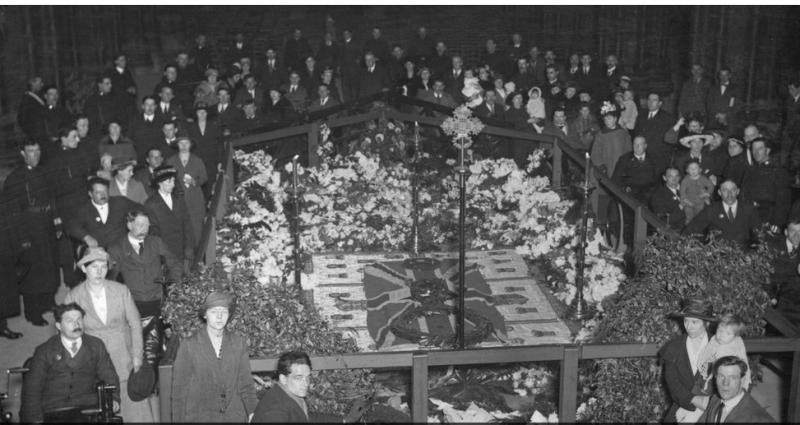
This image shows the people who gathered prior to the ceremony to seal the grave of the unknown warrior in Westminster Abbey on 18 November 1920, before the wreaths were removed.
"An unknown soldier."
The minds of many soldiers who returned will be carried back to some barren field or shattered trench where a rough cross or even a simple upright strip of wood used to stand rudely inscribed with just those words. They were melancholy graves. Sometimes men fought among them and even in them. On many a trench in the Ypres salient or the devastation of the Somme, these rude and insecure memorials of a soldier's grave would obtrude in a trench parapet, firestep, or traverse. "Here lies a British soldier." "Here lie two brave Frenchmen and one Belgian." "Here lies three Fritzes." "Here lies a Digger."
One was found a notice "Here lie most of a company of the Grenadier Guards."
The notices were myriad in the battle zone which remained a battle zone for nearly four long years. Sometimes away from the trenches one might find simply a bayonet stuck at the head of a little mound, and a tin hat or a kepi, dipping peak downwards, surmounting the bayonet. There could be no more striking expression of rest and quiet than those solitary little graves; the drooped head-gear often stained and bullet-holed, told everything. The men who buried their fallen comrades there knew most of what life could teach them; in perfect comprehension of the grief in the world beyond the fighting line, they pushed the bayonet into the ground at the dead man's head, placed the cap upon it, and left no name. There are few things more mournful and expressive than a dead soldier's empty cap, the last remnant of him above earth.
From all the vast areas of graves on the latest battlefields of France and Belgium-graves which special parties of men are now recording and labelling with definite names and dates-one of the few inevitable unidentified bodies is now to be brought home, and saluted with national honours in recognition of them all-known and unknown alike. In the ruin and desolation of thousands of square miles of battlefield many a soldier's body will never be identified, and some will not even be found. Many a man was blown to pieces by shell or mine explosion. In some places the interminable bombardment of artillery so battered and altered the ground as to obliterate small natural undulations. Thus some graves were buried and reburied too deep ever to be found. Nevertheless the grief, lighted up now with a little pride, of bereft families all over the Empire will extend the Armistice Day honours over "an unknown warrior" to cover the last resting-place, wherever it may be, of the bones of every fighting man who fell in France or Gallipoli, Belgium or Palestine, every land theatre of war and every sea. It will place the national mourning of the plain soldier on a level with the "full military honours" to the greatest leader of armies. It brings one of the devoted "other ranks" to rest in the tomb of Britain's most glorious dead, the foremost sailors, soldiers, and statesmen of our history.
All through the war the heart of the nation went out with unforgettable emotion to the plain, common private, to the simple Digger, to the men in the front line, sometimes drowned in mud or burning with fever, or their feet rotting in the frost and wet, tortured in the strain of shell fire, often hating their own bodies under the afflictions arising from surrounding filth and corruption. They bore the burden of the war. Many a Victoria Cross hero was never heard of because he did the deed unseen or did not live to hear his comrade's praise of him.
We shall bow our heads on Armistice Day to those men and the supreme cross they won-to the little wooden cross, and the unknown soldier. The Sydney Morning Herald. (1920, November 9). The Sydney Morning Herald (NSW : 1842 - 1954), p. 8. Retrieved from http://nla.gov.au/nla.news-article16874338
The Unknown Soldier's grave in Westminster Abbey, which was officially unveiled on 11 November 1920. On 11 November 1920, Armistice Day, the coffin was carried in procession through the crowds gathered on London's streets, on its way to the Cenotaph in Whitehall.
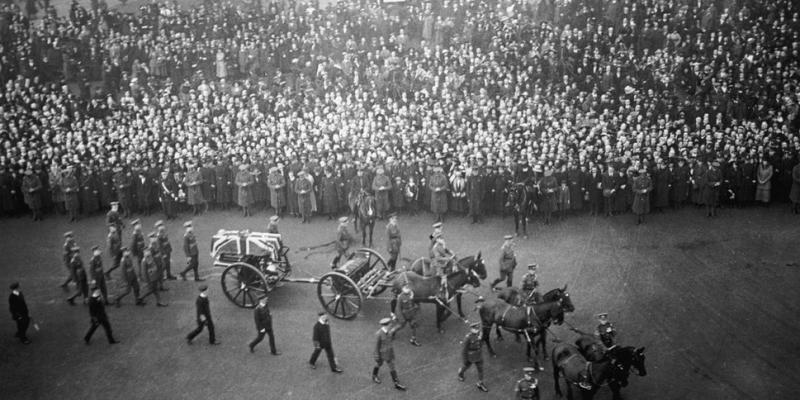
Field Marshal Douglas Haig and Field Marshall John French, first Earl of Ypres, walked beside the coffin of the Unknown Warrior as it was carried in procession from Victoria station to the Cenotaph. King George V placed a wreath on the coffin of the unknown warrior after it arrived at the Cenotaph.
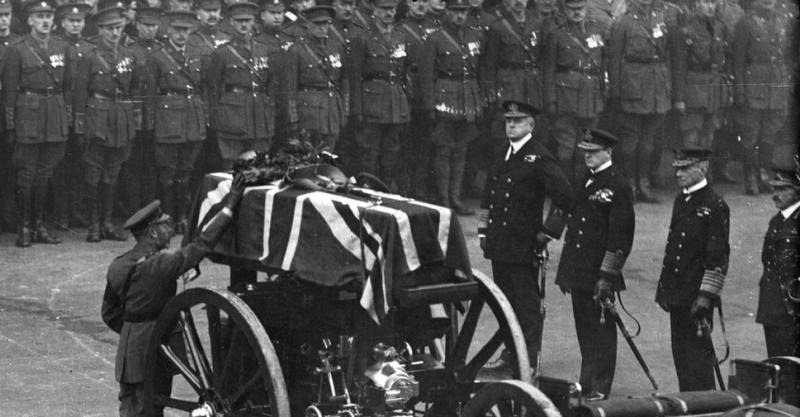
Unknown soldiers were interred with full military honours in Westminster Abbey in London and at the Arc de Triumph in Paris. This entombment in London preceded most other allied nations adopting the tradition of entombing unknown soldiers over the following decade. After the end of the Second World War, the Australian and British governments changed the name to Remembrance Day. Armistice Day was no longer an appropriate title for a day which would and should commemorate all war dead. Each year Australians observe a one minute silence at 11 am on the 11th of November. This mark of respect is in memory of those who died or suffered in all wars and armed conflicts. 2013 is the 95th anniversary of the armistice on 11 November which ended the First World and as Remembrance Day a minute given to remember all the Australians who have served in this conflict and every conflict since. (1.)
Monday’s Remembrance Day Commemorative Service was conducted by Vice President of Avalon Beach RSL sub-Branch, John McInereny. The Remembrance Address was given this year by Cr. Jacqui Townsend, Mayor of Pittwater. Jennifer Harris attended as representative for Hon. Bronwyn Bishop, Federal Member for Mackellar. As is the custom at Avalon Beach RSL sub-Branch, Legacy widows were among invited Guests of Honour and each year it is expressed as a fitting tribute to have those whose husbands served to attend this service and its luncheon. The Hymns were led again this year by the wonderful Avalon Voices.
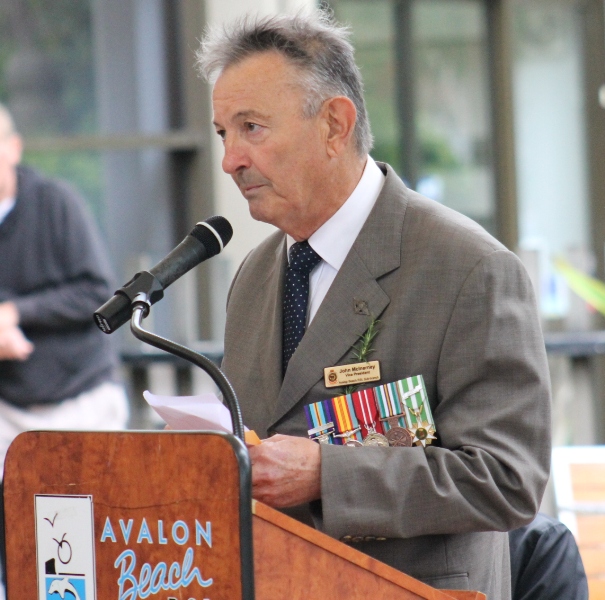
Vice President of Avalon Beach RSL sub-Branch, John McInereny.
Mr. John McInerney gave the Prayer for the Services and Mr. Neil Johnston, Member of Avalon Beach RSL sub-Branch gave the Prayer for the Fallen. John McInerney read the Ode of Remembrance. The Catafalque Party was formed by Australian Air Force Cadets 305 Squadron.
Commodore Graham Sloper AM RAN (Rtd) was presented with a Life Membership from the returned and services League of Australia at the luncheon. Mr. Sloper kindly allowed us to interview him regarding this and other upcoming events. Page here.
The record of this year’s Address, by Cr. Jacqui Townsend, Mayor of Pittwater:
Remembrance Day Address 11/11/2013— Avalon Cenotaph
Good Morning. I'd like to pay my respects to the spirits of the Guringai people on whose land we gather today.
I'd also like to pay my respects to the Legacy widows, who know too well the struggles of war and what they selfishly gave to build a better life for all of us.
Today is Remembrance Day.
On the 11th hour of the 11th day of the 11th month each year Australians, along with others across the world, gather to remember those who died in the conflict of wars.
We gather to reinforce to our community the importance of remembering the sacrifice of those lost.
We gather as a mark of respect to observe one minute’s silence and to reflect on our men and women who served, who died and who live with the effects of war and conflicts.
In us wells awe and thankfulness for all of these selfless Australians, who gave themselves to war efforts our country has embarked upon.
To our men fighting on the Front Line, and to the women who dealt with the consequences of war, managing their families, they are all remembered.
One reflection reported this week read “If we are to survive as a progressive nation we have to start tending to our living because the wounded: our poor, our underemployed youth, our struggling seniors, shouldn't be left to die on the battleground of modern life.” (2.)
As a community leader I believe there is one lesson that war has taught all of us – we must strive to remember what has past, reflect on how we got to this point in time, and remember all of those who helped us achieve what we have today.
But we also need to have empathy and acknowledge there are causalities of war and of our modern society – and we must al;so remember them
This past week I spent time with young Army men who have seen their share of conflict. What I’m left with from this time shared is mateship. Putting your mate first- their wellbeing, putting their life before yours in conflict. Looking after your mates when they themselves are unable to.
We can learn a lot from the Aussie Mateship of looking out for each other when we may be unable to. Let us not forget about our mates, those who have served, those who are suffering the effects of war, and those who are less fortunate than us.
I leave you with some words from the Eulogy at the 20th anniversary of the reinterment of the Unknown Australian Soldier in the Australian War Memorial’s Hall of Memory in 1993:
“We have gained a legend – a story of bravery and sacrifice and with it, a deeper faith in ourselves and our demorcarcy and a deeper understanding of what it means to be Australian.” (3).
Lest we forget.
References:
1. Australian War Memorial
2. Harry Leslie Smith, The Guardian, Friday 8 November 2013.
3. Don Watson, speech writer for eulogy delivered by the Prime Minister, The Hon. P.J. Keating MP, at the funeral service of the Unknown Australian Soldier, 11 November 1993.
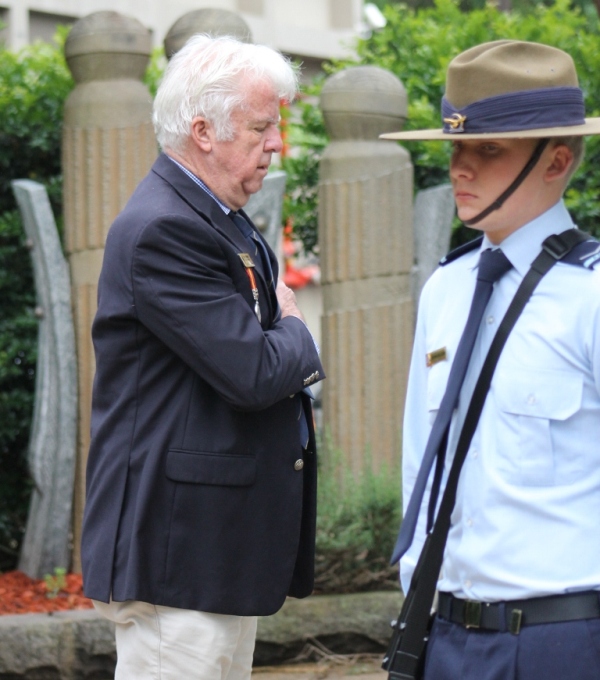
Wreath Laying: Robert Dodds, Vice-President Avalon Beach RSL sub-Branch
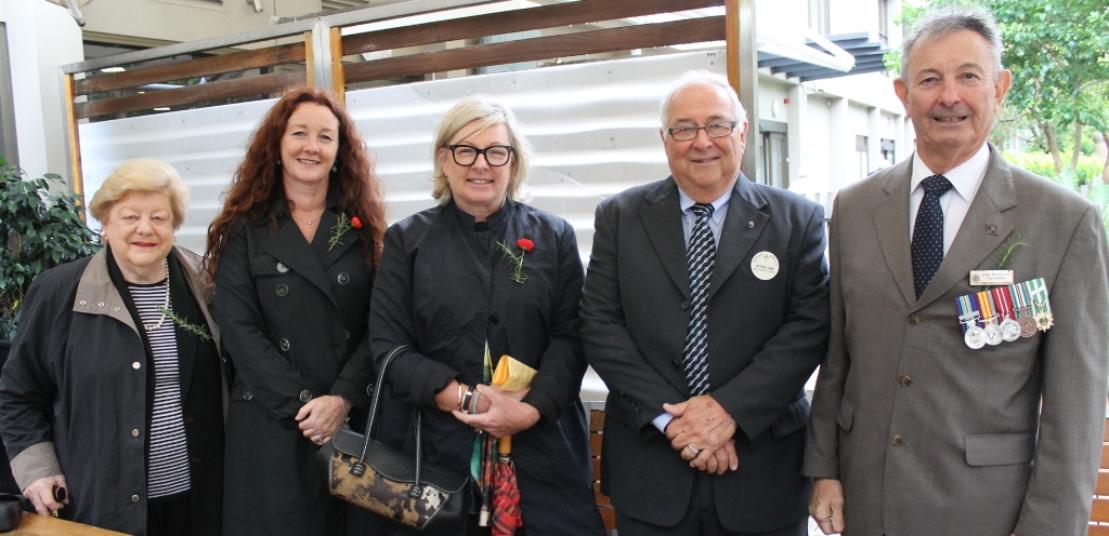
Left to right: Jennifer Harris, representative for Hon. Bronwyn Bishop, Federal Member for Mackellar, Cr. Kylie Ferguson, Deputy Mayor of Pittwater, Cr. Jacqui Townsned, Mayor of Pittwater, Jeffrey Lowe, Sydney Legacy - Manly Warringah Pittwater, John McInerney, Vice-President Avalon Beach RSL sub-Branch.
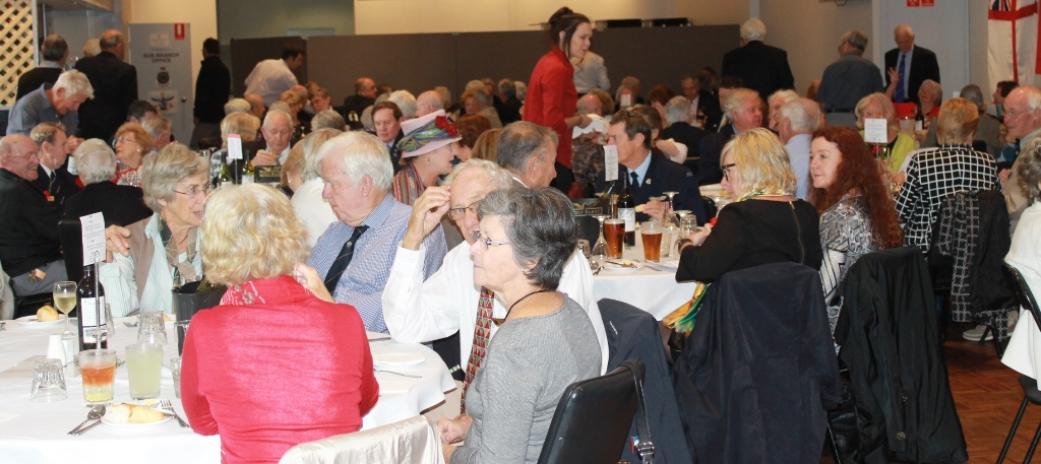
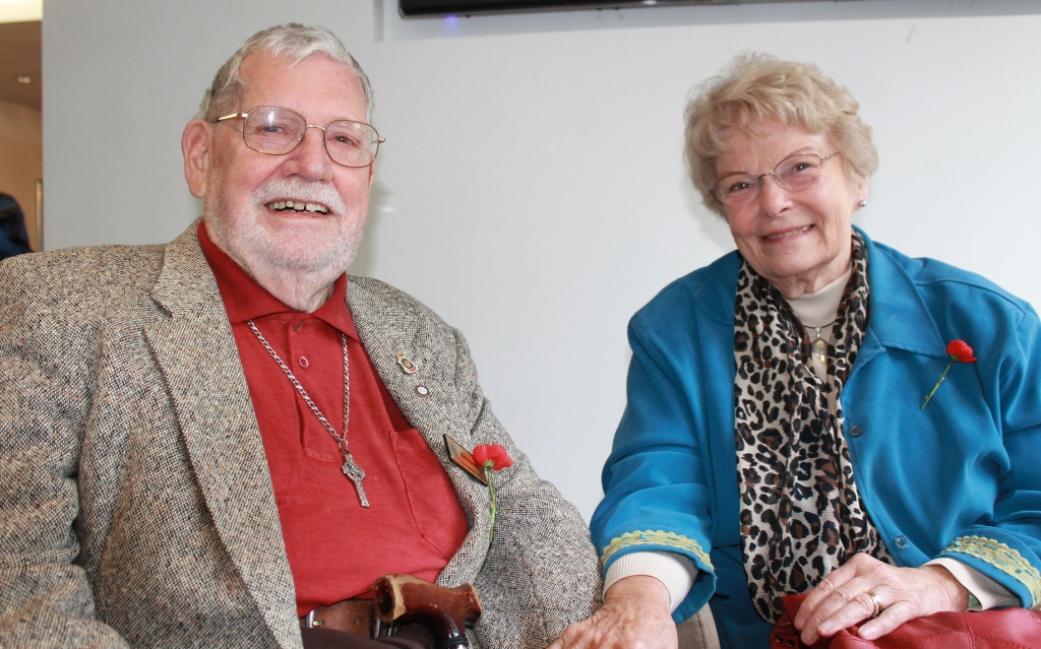
Sid and Lesley Bowers.

Left to right: Betty Kopetko, Joyce Taylor, Doreen Cherry, Una Levy.

Left to right: Philip and Louise Alston, Neil McGowan, Avalon Beach RSL sub-Branch, Robert Dodds, Vice-President Avalon Beach RSL sub-Branch.

Left to right: John Anderson, Avalon Beach RSL sub-Branch Treasurer, Wilga Rose, Irene Anderson, Harvey Rose.

Mary and Ron Jones.
Report and Pictures by A J Guesdon, 2013.